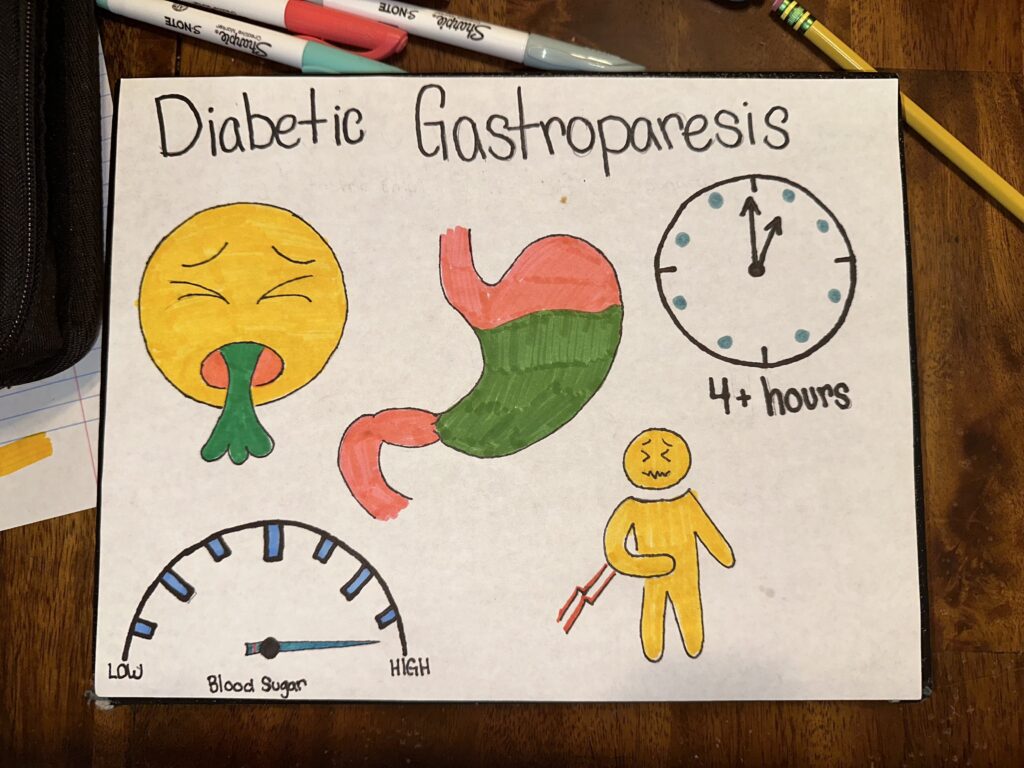The objectives I am relating to Diabetic Gastroparesis are State the 4 functions and 6 steps of the digestive system. Relate the stomach, pancreas, liver, gallbladder, large and small intestine, and esophagus to these functions. Know the order of organ function and path of food during digestion. Diabetic Gastroparesis is caused by high blood sugars damaging the nerves in your stomach. When the vagus nerve is damaged it affects the way your digestive system works. A fully functioning stomach when properly working, the brain sends signals through the nerves to the stomach muscles to churn the food and break it down. When these nerves are damaged the muscles do not work as well and are slower. This causes the food in your stomach to sit longer. Normally food will sit in your stomach from 40 minutes- 2 hours. With gastroparesis once it takes longer than 4 hours for the food to be broken down in the stomach is when it would be considered gastroparesis. Some people it can take up to 12 hours to digest the food. Because of the delay in food absorption this can cause greater damage for diabetics. After taking insulin and the food taking a while to break down and glucose to be absorbed. Diabetics can possibly fall into a hypoglycemia (blood glucose <70 mg/dL) state than having to take some kind of glucose to correct this; this can later cause hyperglycemia(blood glucose >200 mg/dL) and cause further damage to the vagus nerves and other nerves in the body. Common ways to help with gastroparesis usually start with life modifications. This can be from food, lifestyle, and meds you already take. So for diabetics when taking insulin sometimes taking insulin not as early before eating. Eating more frequent smaller meals. This helps in this particular circumstance because the stomach is not having to break down as much food. Changing what kinds of food you are eating. So foods with less fiber to it are easier to digest in your stomach.Also avoiding high fatty foods can help with digestion. If this is not enough, medications can also help. Erythromycin is commonly used to help with the movement of the gastrointestinal tract. Erythromycin is usually used as an antibiotic but was found that it also binds to the motilin receptors and contracts and stimulates the gastrointestinal tract resulting in increased gastrointestinal motility. Symptoms usually seen with gastroparesis that are seen can be bloating, weight loss, vomiting, nausea, and abdominal discomfort. It can also lead to more serious conditions such as anorexia, starvation, extreme dietings and self imposed vomiting.


This project is on Diabetic Gastroparesis. It covers what the disease is, what causes it, symptoms, and how to reduce symptoms. The creative aspect is a simplified visual aid that shows what diabetic gastroparesis is and how it affects a person, including causing nausea and vomiting, as well as fluctuation of blood glucose levels. Diabetic gastroparesis is a disease that affects the digestive system. It’s caused by damage to nerves in the stomach by high blood sugar. This results in digestive functions slowing down, and food staying in the stomach longer. While food normally stays in the stomach for 40 minutes to two hours, food will stay in individuals with diabetic gastroparesis for upwards of four hours. Four hours is the baseline that qualifies for gastroparesis. Because of this, some individuals become hypoglycemic. Severe hypoglycemia is very dangerous, but even mild cases are generally unpleasant for the individual. If they attempt to correct this, it can lead to hyperglycemia, which continues to damage nerves and causes negative symptoms for the individual. This would worsen the condition. Some symptoms usually seen include nausea, vomiting, weight loss, abdominal pain, and bloating. It can also cause more serious conditions, such as anorexia, starvation, and self-imposed vomiting. This project also covers ways to lessen symptoms, including changes that can be made to the diet as well as medication. The dietary modifications include eating smaller portions and eating foods with less fiber or fat. Individuals can also take erythromycin, which helps with the movement of the gastrointestinal tract.